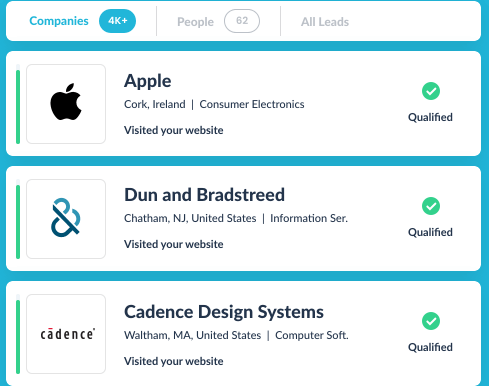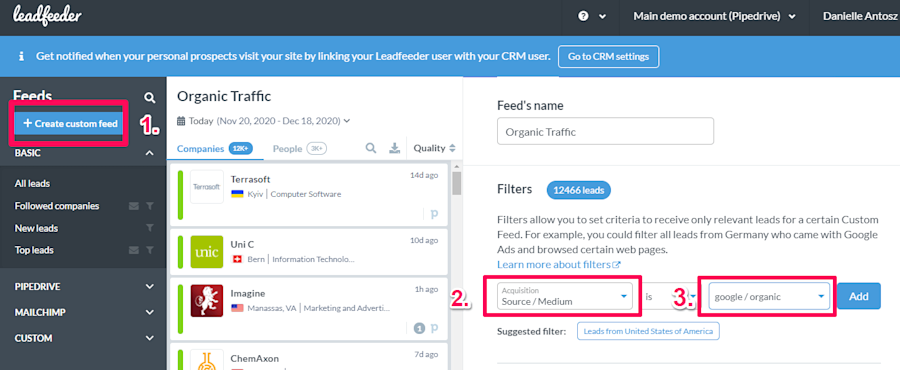Quick, what's the most frustrating thing about SEO?
(Besides all those Google core algorithm updates.)
For most SEOs, it's proving all those big changes (and small tweaks) actually do drive sales, not just traffic.
Site maps, robot.txt files, and keyword research are just the start — you also have to make sure that everyone understands the impact your genius has on the bottom line.
I get it.
Unfortunately, there's no magic SEO wand. But, we do like to think Leadfeeder is pretty close.
Leadfeeder is primarily a lead generation software — but there are tons of benefits for SEOs, too. Here's what you need to know.
Note: Ready to maximize B2B leads using SEO magic? Try Leadfeeder free for 14 days to improve your ROI by tracking which companies visit your website and what pages they visit.
Leadfeeder for SEOs: Generate B2B leads & prove SEO ROI
Leadfeeder is a website visitor tracking software that helps B2B marketers and sales teams turn website visitors into leads by matching IP data with our contact database.
That's the official spiel.
But what does it mean for your day-to-day work?
Leadfeeder shows you what companies visit your website, what they do when they get there, and then makes it easier to sort that data with our feed filters.

Leadfeeder can also increase the quality of leads SEO generates and make it easier to prove ROI — which makes it easier to brag about how fabulous you are.
Here's how.
Use Leadfeeder to Track SEO ROI
There's no one-size-fits-all method for tracking SEO ROI.
Methods like last-touch attribution (which, of course, gives all the credit to the last touch) can leave a lot of credit — and ROI — on the table.
Lame.
I'm all for teamwork, but incorrect attribution can lead to wasting time, resources, and money.
At its core, ROI is pretty easy to calculate — subtract the cost of SEO from revenue and then divide it by the overall cost of SEO.
It looks something like this:
ROI = (Revenue from Organic Search – Cost of SEO) / Cost of SEO
That doesn't give you the whole picture, though.
You might use Google's Goals or track organic traffic increases to see how your SEO efforts are paying off.
But what about that less direct ROI like higher quality leads or how that perfectly optimized piece of content is driving leads? A little more complex to track, but a pretty effective way to show what SEO is doing.
The truth is, using Google Analytics isn't giving you the whole story. Even your lead generation tools might not provide all the data you need to show the impact of SEO efforts.
Because Leadfeeder helps you identify website traffic, you can better track the number and quality of leads from your SEO efforts.
Track organic traffic and turn them into leads
Yes, you know how to track organic traffic already. (I hope.)
Leadfeeder's custom filter feeds mean you can track not just the amount of organic traffic you get; you can see exactly what leads you are bringing in — and often get contact info for them.
Here's how:
Sign up for Leadfeeder (You knew that was coming, right??)
Set up a custom feed for Source/Medium.

This will show you precisely what leads came to your site via organic search from Google. (You can create a custom Source/Medium feed for Bing as well.)
Here's the cool part — tracking your organic traffic doesn't just tell you how many people visited you. It tells you what companies came to your site so you can send them to sales for nurturing or marketing for retargeting. Check out this sweet use case from Global Call Forwarding.
Protip: Set up a custom feed filter for Source = Direct to tell you when users come to your site directly by typing in your URL. High-five for brand awareness.
Set up filters based on onsite behavior
The average conversion rate is pretty low — somewhere in the range of 2 percent if you are lucky.
This means 98% of site visitors poke around and then head off without ever taking action like leaving their contact info or downloading a white paper.
To be fair, a lot of those people aren't in your target audience. You'd waste a lot of time chasing down every person who visited your site. (You'd also look pretty creepy.)
But what about there's also some traffic that is in your target audience but still doesn't leave their contact info?
With Leadfeeder, you can filter site visitors based on behavioral insights — such as who visited your service page or viewed a specific product page.
Say you're working on a B2B software site and create a new landing page targeting businesses that use account-based marketing. With Leadfeeder, you can track visitors that land on that page — and show if they are higher quality leads —- and then follow up with them.
Optimize landing pages
Fun fact, you can also use Leadfeeder to support your A/B testing as well.
The easiest way to track landing page quality is to track traffic and conversions, right? If one landing page drives more traffic and more conversions (say a white paper download), then clearly that landing page is more effective?
Right? Maybe.
What if one landing page is driving more conversions — but they aren't in your target audience?
Using Leadfeeder's filters, you can filter for visitors that are already in your CRM, visit five or more pages, or any other number of factors you want to sort for. (Here's how to set up number of visits and CRM filters.)
More data = more effective SEO.
Pay attention to the quality of traffic to your site
Do you know what's better than lots of traffic? Better quality traffic.
We'd all rather get 500 monthly visits from qualified leads than 1,000 leads from businesses that aren't even in your target audience.
Leadfeeder makes this possible by helping qualify leads by integrating with your CRM. The higher the engagement rate, the better qualified your leads are.
A quick visit by one person from a company would be considered a low-quality lead. In contrast, several visits (or longer visits) might be regarded as medium or high-quality leads.

Remember, you can also set your own parameters for feeds — for example, you could create a feed for companies from Germany that came from Google organic search and then viewed your services page.
More leads, better SEO ROI with Leadfeeder
Generating leads from SEO isn't just possible — it can be pretty straightforward. Lead generation tools like Leadfeeder can help your company find more leads and even improve the ROI of your SEO.
Here's the thing — SEO is constantly changing. If you want to be effective, that means finding new data and new tools to help you be more effective. Leadfeeder can help prove your SEO is working —- and make it more effective.
Note: Ready to maximize B2B leads using SEO magic? Try Leadfeeder free for 14 days to improve your ROI by tracking which companies visit your website and what pages they visit.
More leads, no forms.
Sounds too good to be true? It’s not. Identify companies already visiting your website and turn them into qualified leads to fuel your sales pipeline.
Show me how


![How to Maximize Your Sales With Leadfeeder [Webinar]](http://images.ctfassets.net/plii0v5gbc4s/3z1uKAAU3OECXj41fa8jic/a3b8b3c211657fd51841a5120569c930/Copy_of_lead-generation-without-cold-calls.png?w=686&q=80)




